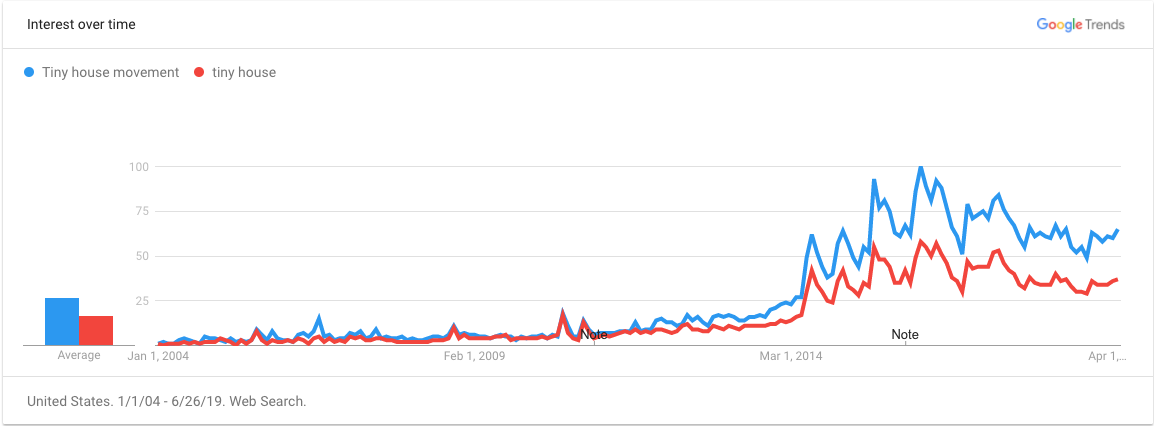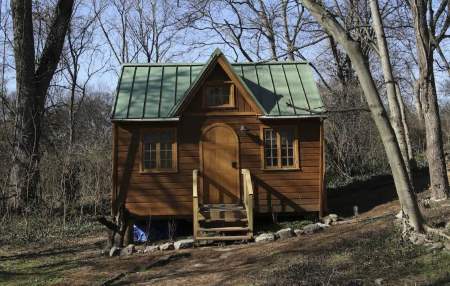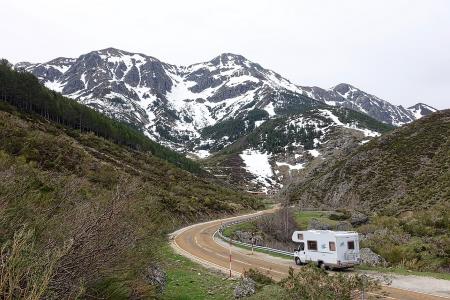Blog

Are Tiny Houses A Fad, Or A Perfect Lifestyle Move?
Tiny houses are finally breaking into the mainstream, with a series of books, newspaper and magazine articles written about them, along with a bunch of TV shows dedicated to them. The idea is perfect and easy to sell to people: throw off the shackles of corporate commercialism by downsizing and living in a property which has just the right amount of space for a minimalist lifestyle. No more, no less. Oh, and because the house is a lot smaller, it will be a lot cheaper to buy and it will have lower monthly bills: allowing you to save more money each month.
So what is the problem? Some people think that despite the benefits, tiny houses are not practical for genuine family living, and even individuals and couples will grow tired of their tiny home. Therefore this ‘fad’ could fade as people get used to the realities of tiny living spaces.
So Are They Just A Fad?
As we explore in more detail later in this article, tiny houses have really started to increase in popularity over the past five years or so. During this time, the world seems to be moving away from commercialism and things like plastic waste: sustainability is now key. Equally, house prices had increased by 3-9% each year over the same time frame.
Is it therefore any wonder that tiny houses – which cut down on waste and commercialism, and are cheaper to buy and run – have grown in popularity? But this could also be the potential downfall of tiny houses: if people are only buying them because they feel forced to, people might stop buying them too.
What do we mean by ‘forced’? Well, some people feel that they have to buy a tiny house because they cannot afford a full-size house, or they see lots of waste and commercialism and ‘rebel’ against it. This makes sense, however the housing market is starting to cool, and it is therefore possible to buy full-size houses for a more reasonable price in many states. Also manufacturers have finally got the message about waste, and are slowly but surely taking steps to reduce its proliferation.
Once full-size houses become (relatively) cheaper to buy, and there is less waste in the world, it may lead to tiny house dwellers (who are craving more living space) giving up their tiny house dream (or rebellion?!) and go back to ‘normal’ living.
The rest of this article – which is partially playing devil’s advocate because we naturally love tiny houses – will take a look at these arguments in more detail.
Recent Tiny House Popularity
It is interesting to look at the rise in people Googling for tiny house information in the past decade:

You will see that the interest in tiny houses increased sharply around the 2014 mark. As touched on earlier, this was around the time when house prices really started to increase sharply (2013-2014), sometimes exceeding 9% price rises. It was also the time that environmentalists started campaigning harder on matters like plastic waste (Greenpeace and Friends of the Earth launched their main anti-plastic campaigns in 2015), and the past few years has seen a general movement away from commercialisation – at least if the ‘live in the moment’ mindfulness movements are to be believed.
This natural increase in public awareness of the tiny house movement led to a rise in mass market media too:

- Some creative Googling shows that many of the news articles relating to tiny houses are from 2014-2015 onwards.
- A range of TV shows were launched which cover tiny houses:
- Tiny House Nation in 2014
- Tiny House World in 2015
- Tiny House, Big Living in 2014
- Tiny House Hunters in 2014
- Tiny House Hunting in 2014
- George Clarke’s Amazing Spaces (a UK show) in 2012
- A large range of books have been released, most of which were published on or after 2014.
Finally, a 2017 article from Curbed says that ESCAPE – one of the larger tiny house producers – seen their tiny house business grow “around 200 percent” from 2014 onwards.
The conclusion from all the above is obvious: tiny houses definitely have become much more popular in the past half a decade or so, and right now this shows no sign of stopping. It could still be a ‘fad’, of course, but before answering that question, let’s take a deeper look at why people want to live in a tiny house.
Main Reasons For Living In A Tiny House
There are many reasons for wanting to live in a tiny house, a couple of which we have already touched on:
- The financial benefit which we touched on earlier. A tiny house is much smaller than a standard house, which naturally means it is a decent amount cheaper to buy. However in addition to the list price, you will also have lower monthly bills: after all, there is less surface area to heat, and a simpler lifestyle can also lead to less electricity being used as well.
- A more minimalist lifestyle is a big plus point. Commercialism often just results in more stuff being purchased… stuff which often is not needed. This leads to wasted money, more things to manage and clean, and more wasted materials.
- You can have ultimate flexibility with a THOW. Being able to pack up and travel to a new area (without worrying about boxing up all your possessions and buying a brand new house somewhere) is a freeing mindset, allowing you to travel more, experience more and see more.
- Tiny houses also use less materials than a full size house, which means that their construction will be better for the environment overall. Why build a relatively large full size house when the majority of the space will be unused, and thus the underlying materials (and harm to the environment) will also be wasted?
- You will spend less time and money on maintenance. After all, a smaller building will have less items and appliances to manage and fix up. Doing the weekly clean will also be easier.
- They are a good way of getting started in life. After all, getting started (usually in your 20s) is hard: trying to get together a big down payment for a house purchase, having to furnish your new house and worry about the constant monthly bills (some of which will be much bigger than you would expect) – all the while trying to find/hold down a job in a job market which has had a few wobbles of late. This ‘big bang’ approach to getting started contrasts with the simpler tiny house experience: getting a tiny home which you can more easily grow into, with lower monthly bills, and which allows you to easily move to a different area if your job search requires it.

Disadvantages Of Tiny House Living
If tiny houses are so perfect, why are people asking whether they are just a fad? Well the answer is simple: there are two sides to every story. Whilst there genuinely are some great benefits to tiny house living, there are drawbacks too:
- They are hard (but not impossible to get finance on, if you (like many people) are unable to stump up the 5-figure amount to buy one outright. This is because many banks are geared up to offer mortgages on ‘normal’ houses. The moment they hear of a tiny house, or one with wheels, mainstream banks will instantly decline.
- Many cities and states still have not got their heads around tiny houses, either. They seem happy with small outbuildings like sheds (which are too small for a tiny house), or large full size houses, but the inbetween case – of tiny houses – seems to be a gray area. Whilst there are some tiny house-friendly areas (such as Spur, Texas), most areas will lead to zoning headaches.
- On a similar note, getting suitable land to house your tiny house on can also be tricky. This is because in addition to the zoning issues, many RV parks do not allow tiny houses to be parked there: they are reserved just for conventional RVs. Whilst this is also changing for the better, it is very zip-code dependent as to whether you live near an RV site which accepts tiny homes.
- The majority of home buyers rate adequate storage as a key factor in their decision making. A NAHB study in 2019 found that 90% of buyers want a laundry room and over 80% require garage storage and some form of pantry, concluding that “The big trend has one word, and that is ‘storage’. People of all ages have an increasing amount of stuff”. Naturally people committed to a tiny house lifestyle would also need to commit to getting rid of most of their ‘stuff’, and living a simpler life: meaning that tiny house living certainly is not for people who consider a pantry and garage as essential.
- It is harder to entertain and/or have parties as a host. After all, there will barely space for a single guest to come and stay: let alone multiple guests. An outdoor space (and nice weather!) would therefore be key if you wanted to entertain.
- You might struggle if you want to start a family. Whilst you can get tiny houses with multiple bedrooms, the reality is that newborn babies (and small children… well, all children!) require a lot of stuff. The vast majority of this new stuff is non-negotiable either: they are essential items for raising a small child. Therefore living in a tiny house might really be a struggle when growing your family.
- Whilst tiny houses are better for the environment than a full size house, there is an element of diminishing returns. After all, you still need lots of wood and drywall. You will still need electric cabling (which is sheathed in plastic-based PVC), and metal pipework, along with a heating/HVAC unit. You will still use in lots of water in your day to day living, along with a decent amount of gas/electricity. Equally, moving your THOW to a different area will require a vehicle to tow you: and the vehicle will not be eco-friendly to run!
When/If The Tiny House Fad May End
A fad usually lasts for a few months, or a year or two at most. Tiny houses have clearly surpassed that level, having been around for over a decade and growing in popularity rapidly in the past five years. So the short answer is that the tiny house ‘fad’ probably will not end, because tiny houses have become established as somewhat mainstream (even if they are uncommon and only make up a small <1% of the market right now).
Plus the minimalist mindset – thought to be a key driver for tiny houses – is actually growing right now, be it in America, Europe, Canada or India. So we do not personally think that tiny house adoption will suddenly plummet, leading to newspapers/magazines to stop writing, TV shows to stop filming and the public to stop Googling about them.
However we said at the start of this article that we are playing devil’s advocate a bit. We also mentioned that the two main drivers for tiny houses is a rejection of waste/excess (commercialism) and a too-expensive housing market. Both of these factors are starting to improve, so we could imagine a scenario where some of the people who bought tiny houses and bought into the lifestyle could start looking at buying a standard house instead.
Plus construction techniques are improving all the time, and it is thought that small (but not tiny) houses could quite easily be pre-fabricated in factories. If this was to happen, the price of 600-1200 square foot homes could drop – giving rise to a new generation of ‘small houses’ which could potentially kill off the ‘tiny house’ fad for some people.

RVs Are Not A Fad
Another bit of ‘evidence’ which says that tiny houses are not a fad are RVs: recreational vehicles are similar to tiny homes in many ways, and they have been popular throughout the 20th century and into the current 21st century. Current figures from the RVIA show that over 10 million American households own an RV, with 9.3% of baby boomers and 11% of 35-54 year olds owning one.
Whilst people use RVs for shorter (usually weekend or week-long) trips, the fact that many Americans spend a large chunk of their vacation time in ‘cramped’ RVs suggest that previous concerns about tiny houses being too cramped (for widespread adoption) are also not correct. In other words, RVs have withstood the test of time and are not a fad – so we do not think that tiny houses are a fad, either.